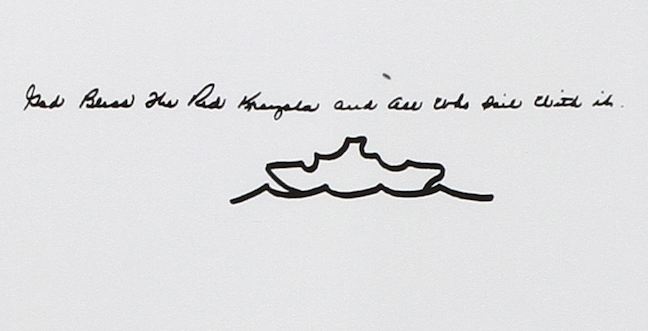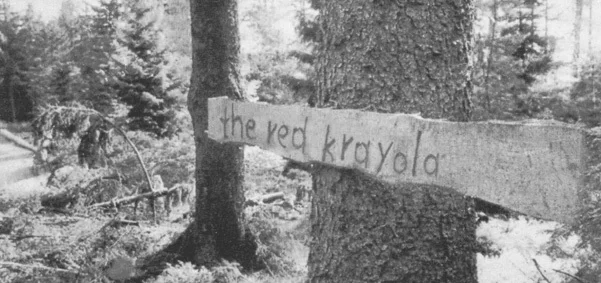UPDATE: We are very sorry but due to a family emergency, The Red Krayola has decided to cancel the Saturday and Sunday sessions and reschedule for a later date. Please email thelabsf@thelab.org with the email address you used to register for a refund – our system can only process refunds on a case by case basis.
Friday, October 20, 2017; 8pm–midnight
Saturday, October 21, 2017; 8pm–midnight
Sunday, October 22, 2017; 2–6pm
Ticket holders may come and go during all three live recording sessions
$20 Guests / $12 Members
Reserve tickets: member login or guest registration
The legendary Psychedelic music rockers, The Red Krayola—founded Houston, Texas, 1966—will appear at The Lab. The lineup for the occasion will feature Mayo Thompson, as usual, and John McEntire of Tortoise, The Sea and Cake. They will record two new songs with texts by their longtime collaborators, the English Conceptual artists Art & Language. Sessions for “Born in Flames II” and “Sword of God II” will be open to the public. For band reference see theredkrayola.org
A Manifesto for The Red Krayola
The melting of historical relations “obliges the mind to go where it need not degrade itself.” It may still fall to the work of art to assert what is barred to politics — resistance of some kind. But when we speak of “resistance,” we know that the idea is inflected by modalities like “being hoped for” and “being just out of reach.” We may also think that it has to be inflected by truculence. It is open to us under these circumstances to attempt the construction of forms of critical negativity that are not merely nostalgic.
What is needed is a resistant aesthetics that is also an aesthetics of resistance within the Gesamtkunstwerk — an aesthetics made in the form of essays — and a practice that can, inter alia, account for relevant aspects of European modernity as well as American critical modernism and the various forms of institutional critique that ensued, one able to act in relation to the fact that this is an artistic culture whose historiography has dissipated the negativity that lay in its origins. To this extent an aesthetics of resistance is an aesthetics of and in failure, an aesthetics fully awake to the fact that the culturally assimilated art product is exhausted by an adequate account of the material conditions of its production and alert to the characteristically degraded state of mind that follows knowing that, an aesthetics that recognizes that there is no automatically practical negativity. It will be a practical aesthetics — of guises, of false identities, of fictions and ghosts.
“Disguise is the first of the plotter’s tasks.” Of course, if you plot you will have to identify with both oppressed and oppressor — be a first-class chump. The Red Krayola supplies a dialectical scrutiny regarding the convention that, in the materiality of music production, the vocal performance of the singer and the craftsmanship of the musicians have been made marginal or irrelevant. It should not be assumed, however, that we stand for any mode-bounded authenticity. It is, rather, that the relation between the singer and the song in a Red Krayola performance — indeed recording — is one that admits of a slippage that approaches fiction or a ghostly hantise. Ghosts and specters are not always fictional entities or the products of delusion. They can operate in and as cultural forms. They shift their shapes; they are identities as virtual as they are actual. They hate what they are and what they have done, even as they take pleasure in being praised for both. They shift their shapes and change their jackets. These latter can be, like music, straight or sporty, solemn or serious, stupid or ugly, ill fitting or neatly tailored.
What is clear is that The Red Krayola is one collaboration — or many — over time that answers, “Does it matter who is speaking?” with the statement, “Since you will never be able to know who is speaking (we’ll try to make sure of that), it will matter a lot or a little according to your ability to make a fiction do its work, according to your taste in ghosts or musketeers, your taste regarding Ethos, Pathos, Bathos, and, of course, Dark Canyon.”
Of course it does matter if you can play or write a lyric. In playing in a group, if you want to know the difference you make, stop playing and listen to others. While The Red Krayola and its collaborators are largely made of specters and other semifictional constructs, none is a victim of the postconceptual delusion that confuses entrepreneurial power with making or doing something like playing, writing, or singing. There are first-order skills in both writing and performance. We are specters who act on and in the work directly. We do not make our work out of the management and authorization of the skills of others. Our sense of that is our sense of collaboration, even though the distribution of labor within it must entail some form(s) of exploitation. Our sense of collaboration is based on the proposition that the solo artist is the sound or sight of the world plus one extracted from the world. What we suggest is some tightening of criteria. This is, however, a tightening that does not seek a return to a prelapsarian state. It is a tightening made after the fall by some of the fallen.
While The Red Krayola is fully implicated within the present Gesamtkunstwerk, we are nevertheless only “modern” in the sense that we envisage its demolition. Our institutional culture is not suited to looking for the unlikely. The commodity is built out of plausibility. We must malinger, fearing and embracing passivity and death. We do not actively confront the corporate tumor fashioned by dispensations of the present with any sense of the virtue of our case; we do not claim that we have virtuously and heroically hidden an explosive charge in it, or even that we know exactly where such a charge may be laid.
We have constructed ourselves essayistically in music and art and in history as significantly virtual, in ways that bring destruction upon us. We are thus, qua musical performers and artists, users misusing the conventions of identity. The virtual truths of contemporary culture are highly instrumental and stable. The “who is speaking or singing or writing” in the practice of The Red Krayola and its collaborators is highly unstable. Our instability does not, however, go to a chaos of tasks and competences. The collaboration is represented by a dialectic of continuing. The voices and the noises of going on constitute an index of performables and performances that may be akin to a heuristic path or a set of heuristic paths. However, while lyric and musical performance are both conceivable as action types, they do not readily conform to a principle of differentiation implied where the finding of different structures by different heuristic paths are all instances of different works. The Red Krayola performances are double(d)-or-more works that are made out of structural and heuristic differences —contradictions — that are internal to them.
Let us add to this sense of paradox and confusion by saying that, in the limit, we are often formalist. Ours is a formalism that does not fear the naturalism that strives to match words and music. A formalistic mismatch may find itself juxtaposed to a moment of “naturalism.” It is possible that in such a circumstance the former will displace the latter. A “naturalism” of voice may be, for example, more implausible than a disguise. A rant in the tune of Lounge Bossa is “unnatural,” but in displacing a ranting tone a text is “rewritten” with all its menaces intact.
Perhaps in owning up to our being formalist, that we are not at all immune to formalistic observances, we may be suggesting that the work of The Red Krayola preserves some sense of genre. While the music is essayistic, there is no reason that it cannot lay claim to or hang on to a robust sense of genre — at least hypothetically — even as it is incorporated in to the tumor that is the Gesamtkunstwerk. It may be that this would be a sense of genre that is festooned with emergency conditionals: “It’s a pop song just in case it might be an avant-garde art performance”; “It’s a contribution to a conversation, just in case it’s rock ’n’ roll”; and so on. Such conditionals embody our kind of cultural insolence in the face of the Gesamtkunstwerk’s police.
The negative context of the work lies in a truthless negativity that is supplied by the emergency conditional, as with a malingering ghost who says to the institutional management, “You are indeed powerful, but you are blind.” But who is doing the speaking? One of the most pervasive thoughts of Nietzsche is that there are no substantive selves. We imagine, then, that he didn’t think that the fictional characters, specters, and ghosts possessed substantive selves. Leaving aside a few weird and modern Flaubertian excursions, a change in the history of a fictional character would entail a change in their identity. The norms of performance are both powerful and meaningless. They are either structures that go to distinct heuristic paths, as they are heuristic paths that go to different forms or structures, heuristic paths beset by sirens and distractions, by the effects of the emergency conditional, or there are forms and structures that change their shape for similar reasons. That would be heartening. The same song can shift genres by this means, and The Red Krayola shifts its shape. And this shift of shape is not at all analogous to versatility in performance, where the same singer may be able to perform a song in a number of styles. It is rather an instability of identity, a turning away from the question “Who is speaking (or playing or singing)?”
Back to All Events
Earlier Event: October 16
False Starts: Kit Robinson, Jean Day and Tonya M. Foster
Later Event: October 26
The Black Aesthetic: Dreamstates with Saul Williams and Anisia Uzeyman

